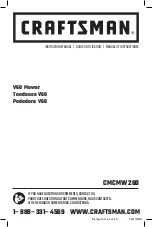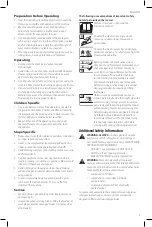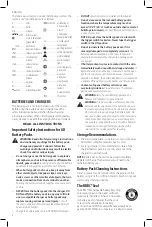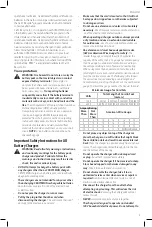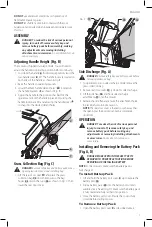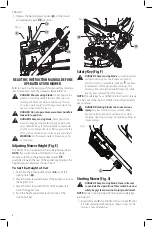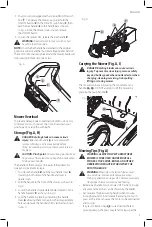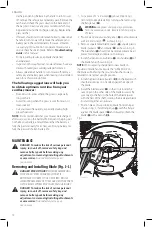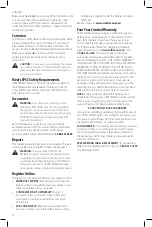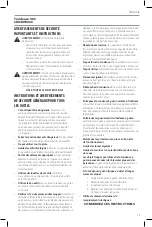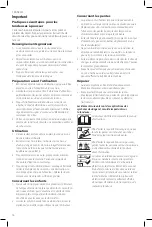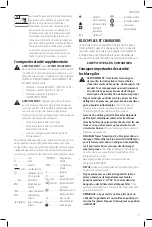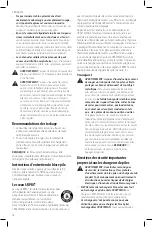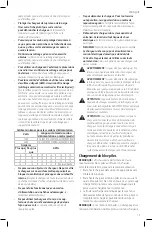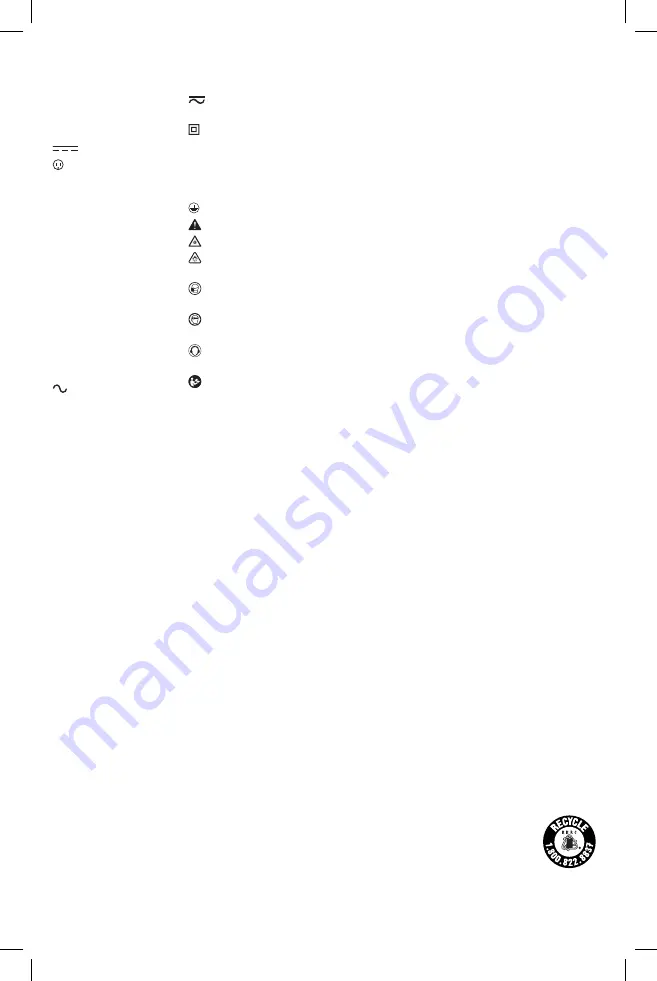
English
4
READ ALL INSTRUCTIONS
Important Safety Instructions for All
Battery Packs
WARNING:
Read all safety warnings, instructions,
and cautionary markings for the battery pack,
charger and product. Failure to follow the
warnings and instructions may result in electric
shock, fire and/or serious injury.
•
Do not charge or use the battery pack in explosive
atmospheres, such as in the presence of flammable
liquids, gases or dust.
Inserting or removing the battery
pack from the charger may ignite the dust or fumes.
•
When battery pack is not in use, keep it away from
other metal objects, like paper clips, coins, keys,
nails, screws, or other small metal objects, that can
make a connection from one terminal to another.
Shorting the battery terminals together may cause burns
or a fire.
•
NEVER force the battery pack into the charger. DO
NOT modify the battery pack in any way to fit into
a non-compatible charger as battery pack may
rupture causing serious personal injury.
Consult
the chart at the end of this manual for compatibility of
batteries and chargers.
• Charge the battery packs only in CRAFTSMAN chargers.
BATTERIES AND CHARGERS
The battery pack is not fully charged out of the carton.
Before using the battery pack and charger, read the
safety instructions below and then follow charging
procedures outlined. When ordering replacement battery
packs, be sure to include the catalog number and voltage.
•
DO NOT
splash or immerse in water or other liquids.
•
Do not store or use the tool and battery pack in
locations where the temperature may reach or
exceed 104 °F (40 °C) (such as outside sheds or metal
buildings in summer).
For best life store battery packs in
a cool, dry location.
NOTE: Do not store the battery packs in a tool with
the trigger switch locked on. Never tape the trigger
switch in the ON position.
•
Do not incinerate the battery pack even if it is
severely damaged or is completely worn out.
The
battery pack can explode in a fire. Toxic fumes and
materials are created when lithium-ion battery packs
are burned.
•
If battery contents come into contact with the skin,
immediately wash area with mild soap and water.
If
battery liquid gets into the eye, rinse water over the open
eye for 15 minutes or until irritation ceases. If medical
attention is needed, the battery electrolyte is composed of
a mixture of liquid organic carbonates and lithium salts.
•
Contents of opened battery cells may cause
respiratory irritation.
Provide fresh air. If symptoms
persist, seek medical attention.
WARNING:
Burn hazard. Battery liquid may be
flammable if exposed to spark or flame.
WARNING:
Fire hazard. Never attempt to open the
battery pack for any reason. If the battery pack case
is cracked or damaged, do not insert into the charger.
Do not crush, drop or damage the battery pack. Do
not use a battery pack or charger that has received a
sharp blow, been dropped, run over or damaged in
any way (e.g., pierced with a nail, hit with a hammer,
stepped on). Damaged battery packs should be
returned to the service center for recycling.
Storage Recommendations
1. The best storage place is one that is cool and dry, away
from direct sunlight and excess heat or cold.
2. For long storage, it is recommended to store a fully
charged battery pack in a cool dry place out of the
charger for optimal results.
nOTE:
Battery packs should not be stored completely
depleted of charge. The battery pack will need to be
recharged before use.
Battery Pack Cleaning Instructions
Dirt and grease may be removed from the exterior of the
battery using a cloth or soft non-metallic brush. Do not use
water or any cleaning solutions.
The RBRC® Seal
The RBRC® (Rechargeable Battery Recycling
Corporation) Seal on the nickel cadmium,
nickel metal hydride or lithium-ion batteries
(or battery packs) indicates that the costs
to recycle these batteries (or battery
packs) at the end of their useful life have already been
paid by CRAFTSMAN. In some areas, it is illegal to place
The label on your tool may include the following symbols. The
symbols and their definitions are as follows:
V ......................... volts
Hz .......................hertz
min .....................minutes
or DC ......direct current
...................... Class I Construction
(grounded)
…/min ..............per minute
BPM ....................beats per minute
IPM .....................impacts per minute
RPM .................... revolutions per
minute
sfpm ................... surface feet per
minute
SPM ....................strokes per minute
OPM .................... oscillations per
minute
A .........................amperes
W ........................watts
or AC ...........alternating current
or AC/DC .... alternating or
direct current
...................... Class II
Construction
(double insulated)
no .......................no load speed
n .........................rated speed
......................earthing terminal
.....................safety alert symbol
.....................visible radiation
..................... avoid staring at
light
..................... wear respiratory
protection
..................... wear eye
protection
..................... wear hearing
protection
..................... read all
documentation
IPXX .................... IP symbol

